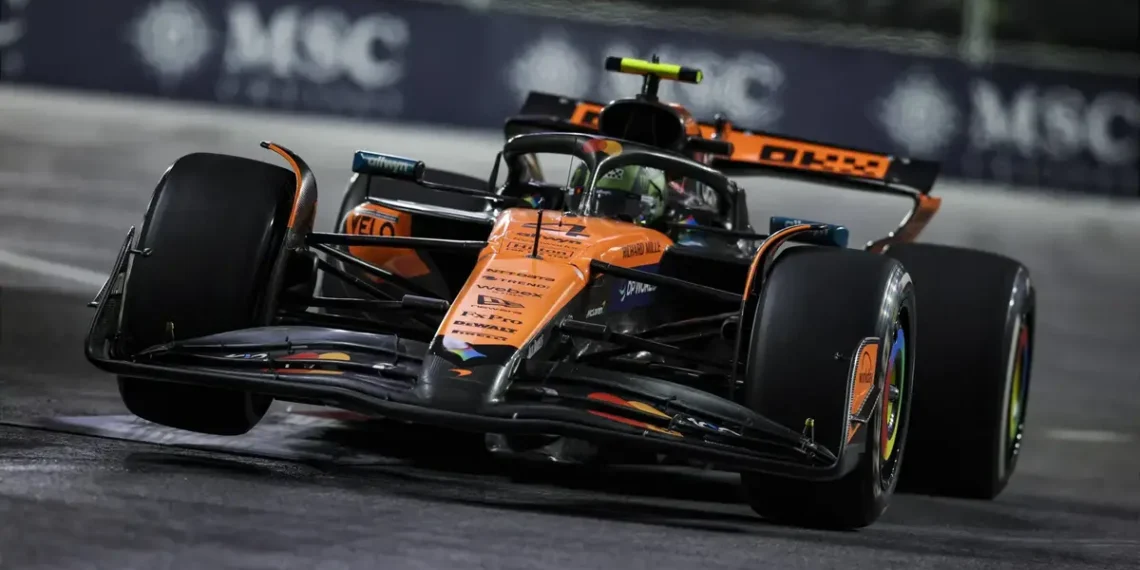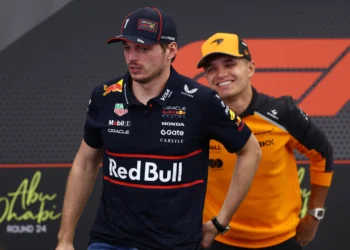McLaren’s Shocking Disqualification: A Deep Dive into the Las Vegas Plank Controversy
In a jaw-dropping twist at the Las Vegas Grand Prix, McLaren found itself at the center of a scandal that has left fans and experts scratching their heads. The team’s double disqualification, a direct result of worn planks on their Formula 1 car, raises critical questions about design choices and performance strategies. Unlike the expected front skid wear, the infringement occurred at the rear—an anomaly that could reveal the underbelly of McLaren’s racing strategy.
This season, McLaren has been a force to reckon with, riding high on the advantages of its MCL39 chassis, which predominantly relies on its front skids. With rivals scrutinizing every aspect of McLaren’s performance, the focus was firmly on the front blocks, which have been the heavy lifters in creating downforce. But the sudden disqualification points to a deeper issue that may involve more than just miscalculations in ride height.
The Ingenious Suspension Design
The core of McLaren’s advantage this season lies in its innovative suspension design, a feat that has allowed the team to run a notably lower front end. This strategy has not only enhanced aerodynamic efficiency but has also shifted the wear pattern of the skid planks. Observers note that Oscar Piastri’s cockpit has been particularly impacted by this design, with excessive heat generated from the front skids necessitating a heavily insulated seat—one even adorned in gold foil.
Inaki Rueda, sporting director for Sauber, shed light on the implications of running a low front end. “Most cars this year are wearing the rears,” he stated, emphasizing how teams that manage to pivot downforce to the front can achieve a performance edge. This clever design is not without its challenges; managing the conflicting demands of downforce distribution while preventing excessive rear wear is a tightrope walk that McLaren has seemingly mastered.
The Las Vegas Shockwave: A Rear End Revelation
So, why did McLaren falter in Las Vegas with a rear skid issue? Speculations arose about wild rumors of teams employing expanding titanium skid blocks—a tactic quickly dismissed by both the FIA and engineers. The focus for teams should always be on protecting skid blocks, not allowing them to wear down. This controversy highlights how the regulatory landscape is evolving, with the FIA becoming more adept at spotting potential loopholes and ensuring compliance through rigorous measurements.
Recent advances in FIA measurement tools have led to heightened scrutiny. McLaren’s disqualification was attributed to measurements that showcased their rear skid blocks at 8.93mm—just over the legal limit. In contrast to previous races, where competitors like Lewis Hamilton faced disqualifications for similar infractions, the precision in measurement tools has become a game changer, increasing the stakes for teams.
Pressure Mounts: The Need for Performance
As McLaren pushes for increased performance, particularly with the looming threat of Red Bull, the Las Vegas race serves as a cautionary tale. Reports indicated that the team was running closer to the ground than ever, a calculated risk that ultimately backfired. Andrea Stella, McLaren’s team principal, acknowledged the lessons learned from previous races, asserting that adjustments in aerodynamic configuration were critical.
However, the adjustments may have inadvertently increased rear downforce, leading to potential porpoising and heightened plank wear—a situation exacerbated by challenging track conditions. The absence of practice runs meant that the team was unprepared for the rigors of race day, compounding their issues.
The Road Ahead: An Internal Review Unfolds
In the wake of the disqualification, McLaren has launched an internal review to dissect the failure and ensure that its MCL39 can regain its competitive edge before the next race in Qatar. This incident calls into question whether the team can continue its championship battle without reassessing its design philosophy and performance strategies.
As McLaren navigates this precarious landscape of performance, regulations, and engineering challenges, the urgency for answers is palpable. The Las Vegas disqualification could be a pivotal moment in the season—one that might redefine the trajectory of McLaren’s championship aspirations. The intensity of competition has ramped up, and the racing world is watching closely as McLaren attempts to rebound from this shocking setback.










